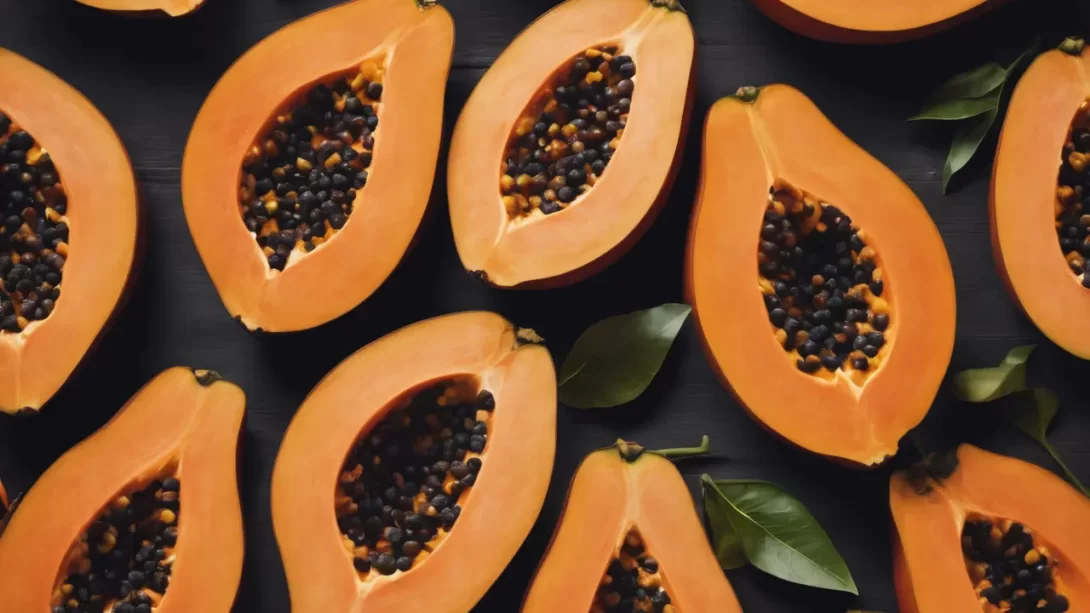Papaya, a tropical fruit known for its vibrant color and sweet taste, has become increasingly popular across the globe. Originating from Central America and Southern Mexico, papaya is now cultivated in several tropical and subtropical regions worldwide. Understanding the seasonal availability of papaya is crucial for consumers looking to enjoy this fruit at its peak of flavor and nutritional value.
Papaya
The papaya plant, Carica papaya, is a tropical tree-like herb. It grows rapidly and can bear fruit within a year of planting. Papayas are known for their large, oval shape, with a green exterior that turns yellow or orange as it ripens. Inside, the fruit has a vibrant orange or red flesh and contains numerous small, black seeds. There are several varieties of papaya, each varying slightly in size, taste, and texture. Some popular varieties include the smaller, sweeter Hawaiian papaya and the larger, less sweet Mexican papaya.
Papaya Growing Regions and Climate
Papayas thrive in warm, tropical climates and are predominantly grown in regions like Brazil, India, Indonesia, Nigeria, and Mexico. These areas offer the ideal conditions for papaya cultivation, including ample sunlight, high temperatures, and well-drained soil. The plant is highly sensitive to frost and does not tolerate cold temperatures, which is why its cultivation is limited to regions with a consistently warm climate.
Seasonal Availability of Papaya
While papayas can be cultivated year-round in some tropical regions due to their favorable climate, there are still peak seasons for harvesting. In countries like Mexico and Brazil, the main harvesting season typically falls between early summer and fall. However, this can vary based on specific regional climates and weather patterns. For example, in some parts of India, papayas are harvested mostly during the winter months. The variation in seasonal availability across different regions ensures that papayas are available to consumers throughout most of the year.
Factors Affecting Papaya Seasonality
The seasonality of papaya is influenced by several key factors. Weather patterns play a significant role; excessive rainfall or temperature fluctuations can impact the growth cycle and fruit quality. Cultivation practices, such as the use of greenhouse technology, can extend the growing season in some regions. Additionally, regional climate differences significantly affect the timing of the growing season. For instance, papayas in tropical regions may have multiple harvests in a year, while those in subtropical areas might have a more restricted growing season.
How to Identify Ripe Papayas
Selecting a ripe papaya is essential for enjoying its best flavor and texture. A ripe papaya typically has a yellowish skin and yields slightly to gentle pressure. The fruit should feel heavy for its size, indicating juiciness. A sweet, fragrant aroma is another indicator of ripeness. If a papaya is partially green but needs to be used soon, it can be ripened at home by storing it at room temperature. Once it fully ripens, it can be refrigerated to extend its freshness but should be consumed within a few days.
Benefits of Eating Seasonal Papayas
Consuming papayas during their peak season offers several benefits. Seasonal papayas tend to be fresher, tastier, and richer in nutrients like vitamin C, vitamin A, and enzymes like papain. Eating seasonally also supports local agriculture and is environmentally beneficial, as it reduces the need for long-distance transportation and storage. Additionally, seasonal fruits often come with a lower price tag due to their abundance during peak harvest times.
Papayas in Cuisine and Culture
Papayas play a significant role in various cuisines and cultures. In many tropical countries, they are a staple in diets and are used in both sweet and savory dishes. Fresh papaya is often eaten as is or added to fruit salads, smoothies, and desserts. In some cultures, green, unripe papaya is used in cooking, as in the Thai dish, Som Tam, which is a spicy papaya salad. The versatility of papayas in culinary applications showcases their global appeal and the rich cultural traditions associated with this fruit.
Papaya in Global Cuisine and Culture
Papaya has a cherished place in global cuisine, valued for its versatility and unique flavor. In Latin American cuisine, it is often enjoyed fresh with a squeeze of lime juice, or used in salsas and salads. Asian cuisines frequently use green, unripe papayas in savory dishes like stir-fries and salads. In India, papaya is commonly used in curries and chutneys. Its seeds, with their peppery taste, are sometimes ground and used as a spice. This cultural diversity in papaya’s culinary uses highlights its global popularity and adaptability.
Storing and Preserving Papaya
Proper storage is key to maintaining the freshness of papaya. Unripe papayas can be left at room temperature to ripen, which is usually indicated by a change in skin color and softening. Once ripe, they should be refrigerated and consumed within a few days to prevent over-ripening and spoilage. Papaya can also be preserved by freezing. Peeled, seeded, and cut into chunks, papaya can be frozen and later used in smoothies, desserts, or thawed and eaten fresh.
Nutritional Benefits of Papaya
Papaya is not just a delicious fruit; it’s also packed with nutritional benefits. It’s an excellent source of Vitamin C, which is vital for immune system function, and Vitamin A, important for vision and skin health. Papaya also contains a digestive enzyme called papain, which aids in the digestion of proteins and has anti-inflammatory properties. The fruit is also rich in fiber, antioxidants, and has a low calorie count, making it a healthy addition to any diet.
Conclusion
Understanding when papaya is in season is essential for enjoying the fruit at its best. With its year-round availability in tropical regions and specific peak seasons in various parts of the world, papaya is a versatile and beloved fruit globally. Its incorporation into a wide array of dishes reflects its cultural significance and culinary value. Beyond its taste, papaya offers numerous health benefits, making it a nutritious choice for any meal. Whether eaten fresh, cooked in a savory dish, or blended into a smoothie, papaya is a tropical delight that brings flavor and nutrition to tables worldwide.




